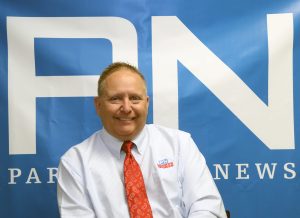Happy 75th Anniversary to PVA
As Paralyzed Veterans of America (PVA) members, we really have something major to celebrate this month — the 75th anniversary of PVA’s official founding.
In January’s column (The Start Of PVA, p. 9), I wrote about the effort that began more than a year prior to the pivotal meeting that took place Feb. 7–9, 1947, in the Vaughan unit of the Hines Department of Veterans Affairs (VA) Hospital in the Chicago area.
The goal of the 300 men and one woman gathered in the Hines VA gymnasium and delegates from seven of eight VA paraplegia wards from across the country was to establish what was then called the Paralyzed Veterans Associations of America.
As reported in the article Chicago Meeting Forms Nat’l. Group in the April 1947 issue of what was then called The Paraplegia News (now PN ), “Colonel John N. Andreios, personal representative of General Omar Bradley, opened the convention with an address of welcome, conveying greetings from General Bradley and the latter’s assurance of his cooperation with the endeavors of the organization.”
The delegates set about writing the articles of incorporation and bylaws, and there was a great deal of discussion involving the organization’s structure, representation, salaries, membership dues and how chapters would vote, among other decisions.
Gilford S. Moss, the driving force behind the PVA Vaughan Chapter who sent letters to the other VA spinal-cord injury and disease (SCI/D) centers to request the Chicago meeting, was selected as national chairman. The
Paraplegia News was adopted as the “official organ” of the association, and a motion was made to advocate for a government study of the disability compensation and inequalities regarding the disabled veterans who required a care attendant.
They also passed four resolutions that established their immediate priorities to help paralyzed veterans to move forward with their lives:
1) They called upon Congress to change legislation regarding the types and costs of specially adapted vehicles veterans could receive and to allow vehicles to be supplied to qualified veteran quadriplegics. Injured veterans gathered Feb. 7–9, 1947, in Chicago to officially form the national organization that would become Paralyzed Veterans of America.
2) They addressed the urgent need for adapted housing.
3) They requested the VA provide accommodations for physical therapists on the same basis as accorded nurses and dietitians.
4) They set up research committees to advocate for and foster physical and medical research that could improve the lives of people with paralysis. While these were all important steps, what’s even more impressive is what it took to get to this point when you consider all these veterans had to overcome.
First, there was the difficulty of coordinating a national convention by sending mail across the country. Second, there were the travel logistics by both air and car. In an era before the Air Carrier Access Act of 1986, veterans with spinal-cord injury and disease (SCI/D) weren’t allowed to fly alone and had to have protective gear placed on their seats in case of incontinence, among other discriminatory policies.
Things have changed and improved in the last 75 years, but at the same time, some of the issues tackled at that founding meeting remain PVA priorities.
Adapted housing and vehicles, advancing SCI/D research and caregiver compensation are all part of PVA’s mission to improve lives and build brighter futures for veterans and others with SCI/D. The founders shaped that mission and laid the groundwork for PVA to grow into the organization it is today.



